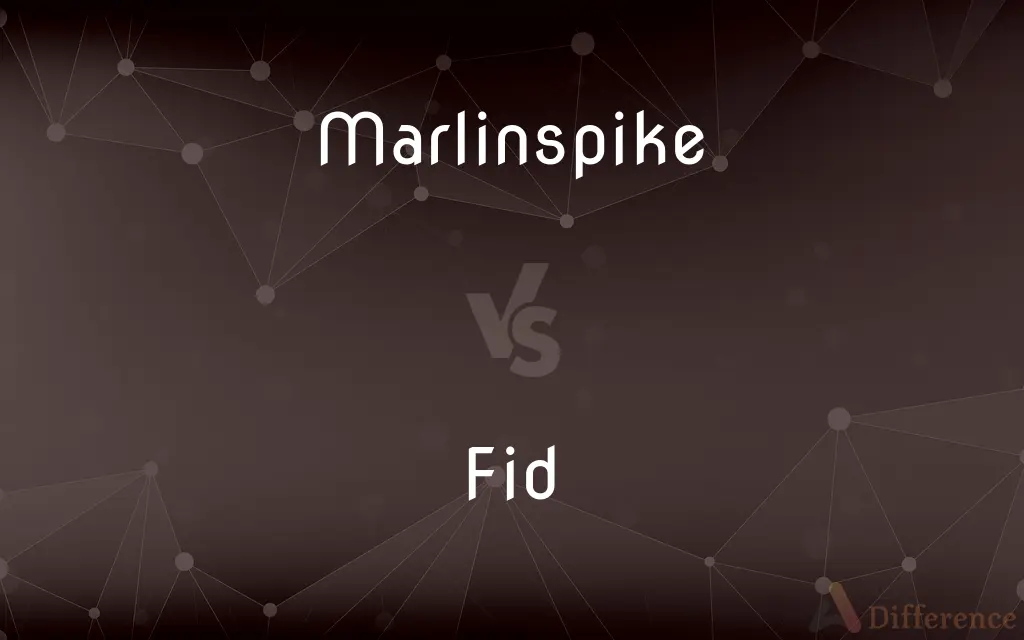Marlinspike vs. Fid — What's the Difference?
Edited by Tayyaba Rehman — By Maham Liaqat — Updated on April 1, 2024
A marlinspike is a tool used in marine ropework for splicing ropes, whereas a fid is a tapered tool used specifically for working with large ropes and splicing.

Difference Between Marlinspike and Fid
Table of Contents
ADVERTISEMENT
Key Differences
A marlinspike is typically made of metal and features a pointed end, designed for splicing ropes, untangling knots, and working with wire rope. It is a versatile tool in a sailor's kit, used not only for manipulating rope but also for other tasks on board. In contrast, a fid is traditionally made from wood or bone and is larger, specifically designed for splicing larger ropes, such as those used in traditional sailing rigs.
The design of a marlinspike allows for detailed work on smaller and more intricate knots and splices, making it suitable for a wide range of ropework tasks. On the other hand, the fid, with its larger and more tapered shape, is better suited for opening the strands of larger ropes to facilitate splicing, indicating its more specialized use in heavy ropework.
Marlinspikes often come as part of a sailor's knife, incorporating a blade for cutting ropes and a spike for splicing and untying knots, offering a multifunctional approach. Fids, however, are typically standalone tools, emphasizing their specialized nature in the splicing process and their importance in maintaining the structural integrity of large ropes.
Despite their different designs and materials, both tools share the common purpose of aiding sailors and riggers in the manipulation and maintenance of ropes. The choice between a marlinspike and a fid depends on the specific needs of the task at hand, with the marlinspike being more general-purpose and the fid being tailored for larger ropes.
The usage of both tools reflects the skill and craftsmanship involved in traditional and modern ropework, showcasing the blend of art and practicality in maritime professions. While the marlinspike is a testament to the versatility required in everyday sailing tasks, the fid represents the precision needed in working with the large ropes that power sailing vessels.
ADVERTISEMENT
Comparison Chart
Material
Typically metal.
Traditionally wood or bone.
Use
Splicing, untangling knots, working with wire rope.
Splicing larger ropes.
Design
Pointed end for detailed work on knots and splices.
Tapered shape for opening strands of large ropes.
Combination with Other Tools
Often part of a sailor’s knife.
Usually a standalone tool.
Suitability
Versatile for a wide range of ropework tasks.
Specialized for heavy ropework involving large ropes.
Compare with Definitions
Marlinspike
A metal tool for splicing and untangling knots.
He used the marlinspike to loosen the tight knot.
Fid
A tapered tool used for splicing large ropes.
The fid was indispensable for splicing the heavy mooring lines.
Marlinspike
Often combined with a cutting blade.
His sailor's knife featured a sharp blade and a sturdy marlinspike.
Fid
Large and tapered for opening rope strands.
The fid’s tapered design made it easy to insert into the rope’s strands.
Marlinspike
Designed for intricate knots and splices.
The marlinspike was essential for the detailed splicing work required.
Fid
Tailored for working with large-diameter ropes.
For the thick hawser, only a fid would do the job.
Marlinspike
Typically made from durable metal.
The stainless steel marlinspike resisted corrosion from the sea air.
Fid
Often made from wood or bone for durability.
His traditional wooden fid had been passed down for generations.
Marlinspike
Suitable for both rope and wire rope work.
The marlinspike made working with the wire rope easier.
Fid
Typically not combined with other tools.
Aside from his knife, the fid was his most used tool on the ship.
Marlinspike
A marlinspike (; sometimes marlin spike, marlinespike, or marlingspike [archaic]) is a tool used in marine ropework. Shaped in the form of a polished metal cone tapered to a rounded or flattened point, it is used in such tasks as unlaying rope for splicing, untying knots, drawing marline tight using a marlinspike hitch, and as a toggle joining ropes under tension in a belaying pin splice.
Fid
A fid is a conical tool traditionally made of wood or bone. It is used to work with rope and canvas in marlinespike seamanship.
Marlinspike
A pointed metal spike, used to separate strands of rope or wire in splicing.
Fid
A square bar used as a support for a topmast.
Marlinspike
A tool, consisting of a pointed metal spike, used to manipulate the strands of rope or cable when knotting and splicing.
Fid
A large tapering pin used to open the strands of a rope before splicing.
Marlinspike
A pointed iron hand tool that is used to separate strands of a rope or cable (as in splicing)
Fid
(nautical) A pointed tool without any sharp edges, used in weaving or knotwork to tighten and form up weaves or complex knots; used in sailing ships to open the strands of a rope before splicing. Compare marlinespike.
Fid
(nautical) A square bar of wood or iron, with a shoulder at one end, to support the weight of the topmast (on a ship).
Fid
A plug of oakum for the vent of a gun.
Fid
A small thick piece of anything.
Fid
A wooden or metal bar or pin, used to support or steady anything.
Fid
To support a topmast using a fid.
Fid
A square bar of wood or iron, used to support the topmast, being passed through a hole or mortise at its heel, and resting on the trestle trees.
Fid
A wooden or metal bar or pin, used to support or steady anything.
Fid
A pin of hard wood, tapering to a point, used to open the strands of a rope in splicing.
Fid
A block of wood used in mounting and dismounting heavy guns.
Common Curiosities
Are there different sizes of fids?
Yes, fids come in various sizes to accommodate different thicknesses of rope.
Do modern sailors still use these tools?
Yes, despite technological advances in sailing, marlinspikes and fids remain essential tools for traditional ropework.
Can a marlinspike be used as a weapon?
Although not designed as a weapon, its pointed end could potentially be used for self-defense in an emergency.
Is a marlinspike necessary for all sailors?
While not absolutely necessary, a marlinspike is a highly useful tool for sailors, especially those involved in regular ropework.
How do you choose between a marlinspike and a fid?
The choice depends on the size of the rope being worked on; use a marlinspike for general purposes and smaller ropes, and a fid for larger ropes.
Are there instructional resources available for learning ropework with these tools?
Yes, numerous books, videos, and online tutorials are available that teach the art of ropework using marlinspikes and fids.
What is a marlinspike used for?
A marlinspike is used for splicing ropes, untangling knots, and working with wire rope in marine settings.
Is it difficult to learn how to use a fid?
The basic concept is straightforward, but mastering splicing large ropes with a fid requires practice.
Can a fid be made of materials other than wood or bone?
Yes, modern fids can also be made from plastic or metal, but wood and bone are traditional materials.
How do modern synthetic ropes affect the use of these tools?
Both tools are still relevant for splicing synthetic ropes, though the specifics of use may vary depending on the rope material.
What's the most challenging aspect of using a fid?
The most challenging aspect is often manipulating large, stiff ropes and achieving a smooth, secure splice.
How has the design of fids evolved over time?
While the basic tapered design remains, modern fids may incorporate ergonomic features or materials suited to modern rope types.
What maintenance do these tools require?
Marlinspikes made of metal should be kept clean and dry to prevent rust, while wooden fids may require oiling to maintain their condition.
Is there a preferred material for a marlinspike?
Stainless steel is preferred for its strength and resistance to corrosion.
Can you use a fid on wire rope?
Fids are generally not used on wire rope, as they are designed for splicing fiber ropes.
Share Your Discovery

Previous Comparison
Nonconscious vs. Subconscious
Next Comparison
Fable vs. EpicAuthor Spotlight
Written by
Maham LiaqatEdited by
Tayyaba RehmanTayyaba Rehman is a distinguished writer, currently serving as a primary contributor to askdifference.com. As a researcher in semantics and etymology, Tayyaba's passion for the complexity of languages and their distinctions has found a perfect home on the platform. Tayyaba delves into the intricacies of language, distinguishing between commonly confused words and phrases, thereby providing clarity for readers worldwide.













































